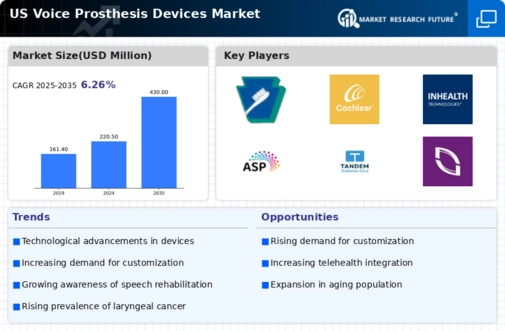Rising Incidence of Laryngeal Cancer
The increasing incidence of laryngeal cancer in the US is a critical driver for the voice prosthesis-devices market. According to the American Cancer Society, approximately 13,000 new cases of laryngeal cancer are diagnosed annually. This rise necessitates effective voice restoration solutions, propelling demand for voice prosthesis devices. As patients seek to regain their ability to communicate post-surgery, the market is likely to experience growth. Furthermore, advancements in surgical techniques and post-operative care have improved survival rates, leading to a larger population of laryngectomized patients who require these devices. The voice prosthesis-devices market is thus positioned to expand as healthcare providers increasingly recognize the importance of voice rehabilitation in enhancing the quality of life for these individuals.
Technological Innovations in Prosthetic Devices
Technological innovations play a pivotal role in shaping the voice prosthesis-devices market. Recent advancements in materials and design have led to the development of more comfortable and effective voice prosthesis devices. For instance, the introduction of silicone-based materials has improved the durability and biocompatibility of these devices, enhancing patient satisfaction. Additionally, the integration of smart technology, such as voice recognition and adaptive features, is becoming more prevalent. These innovations not only improve the functionality of voice prosthesis devices but also attract a broader consumer base. The voice prosthesis-devices market is likely to benefit from ongoing research and development efforts aimed at creating next-generation devices that cater to the diverse needs of users.
Increased Funding for Cancer Research and Treatment
Increased funding for cancer research and treatment is another vital driver for the voice prosthesis-devices market. Government initiatives and private sector investments have led to advancements in cancer therapies and surgical techniques, improving survival rates for laryngeal cancer patients. As more individuals survive cancer, the need for voice prosthesis devices becomes more pronounced. Furthermore, funding for rehabilitation programs is also on the rise, which supports the integration of voice prosthesis devices into post-cancer care. The voice prosthesis-devices market is likely to benefit from this trend, as enhanced funding translates into better resources and support for patients seeking voice restoration solutions.
Growing Awareness and Acceptance of Voice Rehabilitation
There is a growing awareness and acceptance of voice rehabilitation among healthcare professionals and patients, which significantly impacts the voice prosthesis-devices market. Educational initiatives and support groups have increased understanding of the importance of voice restoration after laryngectomy. This shift in perception encourages patients to seek voice prosthesis devices as a viable solution for regaining their communication abilities. Moreover, healthcare providers are increasingly incorporating voice rehabilitation into standard post-operative care protocols, further driving demand. The voice prosthesis-devices market is thus likely to see an uptick in sales as more patients recognize the benefits of these devices in improving their quality of life.
Aging Population and Increased Demand for Healthcare Services
The aging population in the US is a significant driver for the voice prosthesis-devices market. As individuals age, the risk of developing conditions that may lead to laryngectomy, such as cancer or other throat-related diseases, increases. The US Census Bureau projects that by 2030, all baby boomers will be over 65 years old, leading to a higher demand for healthcare services, including voice rehabilitation. This demographic shift is likely to result in a larger patient population requiring voice prosthesis devices. Consequently, the voice prosthesis-devices market is expected to expand as healthcare systems adapt to meet the needs of this growing demographic.




















Leave a Comment